Dragonball Z theme by Snowlegend
Download: DragonballZ_7.p3t
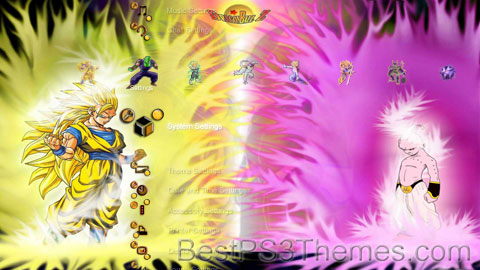
(6 backgrounds)
Redirect to:

The #1 spot for Playstation themes!
Ayami Kojima’s Castlevania v.1.1 theme by Takehaniyasubiko
Download: AyamiKojimasCastlevania.p3t
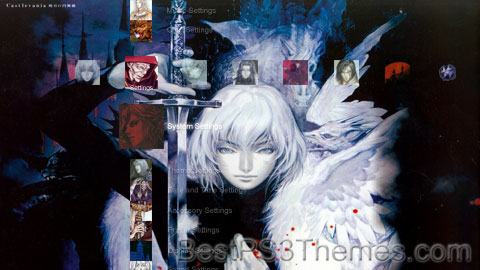
(10 backgrounds)
P3T Unpacker v0.12
Copyright (c) 2007. Anoop Menon
This program unpacks Playstation 3 Theme files (.p3t) so that you can touch-up an existing theme to your likings or use a certain wallpaper from it (as many themes have multiple). But remember, if you use content from another theme and release it, be sure to give credit!
Download for Windows: p3textractor.zip
Instructions:
Download p3textractor.zip from above. Extract the files to a folder with a program such as WinZip or WinRAR. Now there are multiple ways to extract the theme.
The first way is to simply open the p3t file with p3textractor.exe. If you don’t know how to do this, right click the p3t file and select Open With. Alternatively, open the p3t file and it will ask you to select a program to open with. Click Browse and find p3textractor.exe from where you previously extracted it to. It will open CMD and extract the theme to extracted.[filename]. After that, all you need to do for any future p3t files is open them and it will extract.
The second way is very simple. Just drag the p3t file to p3textractor.exe. It will open CMD and extract the theme to extracted.[filename].
For the third way, first put the p3t file you want to extract into the same folder as p3textractor.exe. Open CMD and browse to the folder with p3extractor.exe. Enter the following:
p3textractor filename.p3t [destination path]Replace filename with the name of the p3t file, and replace [destination path] with the name of the folder you want the files to be extracted to. A destination path is not required. By default it will extract to extracted.filename.
Watchmen 3 theme by ZHero
Download: Watchmen3.p3t
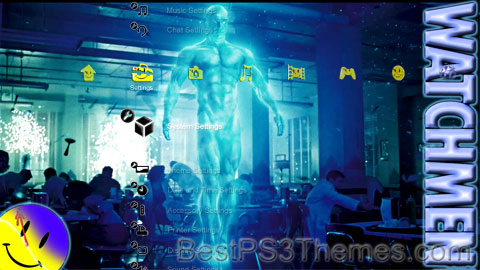
(9 backgrounds)
P3T Unpacker v0.12
Copyright (c) 2007. Anoop Menon
This program unpacks Playstation 3 Theme files (.p3t) so that you can touch-up an existing theme to your likings or use a certain wallpaper from it (as many themes have multiple). But remember, if you use content from another theme and release it, be sure to give credit!
Download for Windows: p3textractor.zip
Instructions:
Download p3textractor.zip from above. Extract the files to a folder with a program such as WinZip or WinRAR. Now there are multiple ways to extract the theme.
The first way is to simply open the p3t file with p3textractor.exe. If you don’t know how to do this, right click the p3t file and select Open With. Alternatively, open the p3t file and it will ask you to select a program to open with. Click Browse and find p3textractor.exe from where you previously extracted it to. It will open CMD and extract the theme to extracted.[filename]. After that, all you need to do for any future p3t files is open them and it will extract.
The second way is very simple. Just drag the p3t file to p3textractor.exe. It will open CMD and extract the theme to extracted.[filename].
For the third way, first put the p3t file you want to extract into the same folder as p3textractor.exe. Open CMD and browse to the folder with p3extractor.exe. Enter the following:
p3textractor filename.p3t [destination path]Replace filename with the name of the p3t file, and replace [destination path] with the name of the folder you want the files to be extracted to. A destination path is not required. By default it will extract to extracted.filename.
Superboy Prime 1 theme by KC
Download: SuperboyPrime1.p3t
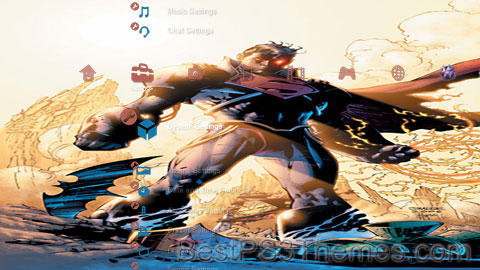
(1 background)
P3T Unpacker v0.12
Copyright (c) 2007. Anoop Menon
This program unpacks Playstation 3 Theme files (.p3t) so that you can touch-up an existing theme to your likings or use a certain wallpaper from it (as many themes have multiple). But remember, if you use content from another theme and release it, be sure to give credit!
Download for Windows: p3textractor.zip
Instructions:
Download p3textractor.zip from above. Extract the files to a folder with a program such as WinZip or WinRAR. Now there are multiple ways to extract the theme.
The first way is to simply open the p3t file with p3textractor.exe. If you don’t know how to do this, right click the p3t file and select Open With. Alternatively, open the p3t file and it will ask you to select a program to open with. Click Browse and find p3textractor.exe from where you previously extracted it to. It will open CMD and extract the theme to extracted.[filename]. After that, all you need to do for any future p3t files is open them and it will extract.
The second way is very simple. Just drag the p3t file to p3textractor.exe. It will open CMD and extract the theme to extracted.[filename].
For the third way, first put the p3t file you want to extract into the same folder as p3textractor.exe. Open CMD and browse to the folder with p3extractor.exe. Enter the following:
p3textractor filename.p3t [destination path]Replace filename with the name of the p3t file, and replace [destination path] with the name of the folder you want the files to be extracted to. A destination path is not required. By default it will extract to extracted.filename.
Code Geass theme by darkliam
Download: CodeGeass.p3t
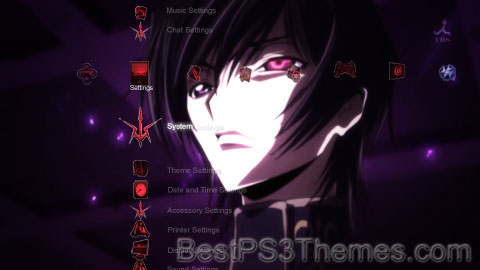
(4 backgrounds)
| Code Geass: Lelouch of the Rebellion | |||||||||||||||||||||||||||||||||||||||||||||||||||||||||||||||||||||||||||||||||||||||||||||||||||||||||||||||||||||||||||||||||||||||||||||||||||||||||||||||||||||||||||||||||||||||||||||||||||||||||||||||||||||||||||||||||||||||||||||||||||||||||||||||||||||||||||||||||||||||||||||||||
 Cover of Code Geass: Lelouch of the Rebellion Blu-ray box set | |||||||||||||||||||||||||||||||||||||||||||||||||||||||||||||||||||||||||||||||||||||||||||||||||||||||||||||||||||||||||||||||||||||||||||||||||||||||||||||||||||||||||||||||||||||||||||||||||||||||||||||||||||||||||||||||||||||||||||||||||||||||||||||||||||||||||||||||||||||||||||||||||
| コードギアス 反逆のルルーシュ (Kōdo Giasu: Hangyaku no Rurūshu) | |||||||||||||||||||||||||||||||||||||||||||||||||||||||||||||||||||||||||||||||||||||||||||||||||||||||||||||||||||||||||||||||||||||||||||||||||||||||||||||||||||||||||||||||||||||||||||||||||||||||||||||||||||||||||||||||||||||||||||||||||||||||||||||||||||||||||||||||||||||||||||||||||
|---|---|---|---|---|---|---|---|---|---|---|---|---|---|---|---|---|---|---|---|---|---|---|---|---|---|---|---|---|---|---|---|---|---|---|---|---|---|---|---|---|---|---|---|---|---|---|---|---|---|---|---|---|---|---|---|---|---|---|---|---|---|---|---|---|---|---|---|---|---|---|---|---|---|---|---|---|---|---|---|---|---|---|---|---|---|---|---|---|---|---|---|---|---|---|---|---|---|---|---|---|---|---|---|---|---|---|---|---|---|---|---|---|---|---|---|---|---|---|---|---|---|---|---|---|---|---|---|---|---|---|---|---|---|---|---|---|---|---|---|---|---|---|---|---|---|---|---|---|---|---|---|---|---|---|---|---|---|---|---|---|---|---|---|---|---|---|---|---|---|---|---|---|---|---|---|---|---|---|---|---|---|---|---|---|---|---|---|---|---|---|---|---|---|---|---|---|---|---|---|---|---|---|---|---|---|---|---|---|---|---|---|---|---|---|---|---|---|---|---|---|---|---|---|---|---|---|---|---|---|---|---|---|---|---|---|---|---|---|---|---|---|---|---|---|---|---|---|---|---|---|---|---|---|---|---|---|---|---|---|---|---|---|---|---|---|---|---|---|---|---|---|---|---|---|---|---|---|---|---|---|---|---|---|---|---|---|---|---|---|
| Genre | |||||||||||||||||||||||||||||||||||||||||||||||||||||||||||||||||||||||||||||||||||||||||||||||||||||||||||||||||||||||||||||||||||||||||||||||||||||||||||||||||||||||||||||||||||||||||||||||||||||||||||||||||||||||||||||||||||||||||||||||||||||||||||||||||||||||||||||||||||||||||||||||||
| Created by | |||||||||||||||||||||||||||||||||||||||||||||||||||||||||||||||||||||||||||||||||||||||||||||||||||||||||||||||||||||||||||||||||||||||||||||||||||||||||||||||||||||||||||||||||||||||||||||||||||||||||||||||||||||||||||||||||||||||||||||||||||||||||||||||||||||||||||||||||||||||||||||||||
| Anime television series | |||||||||||||||||||||||||||||||||||||||||||||||||||||||||||||||||||||||||||||||||||||||||||||||||||||||||||||||||||||||||||||||||||||||||||||||||||||||||||||||||||||||||||||||||||||||||||||||||||||||||||||||||||||||||||||||||||||||||||||||||||||||||||||||||||||||||||||||||||||||||||||||||
| Code Geass: Lelouch of the Rebellion | |||||||||||||||||||||||||||||||||||||||||||||||||||||||||||||||||||||||||||||||||||||||||||||||||||||||||||||||||||||||||||||||||||||||||||||||||||||||||||||||||||||||||||||||||||||||||||||||||||||||||||||||||||||||||||||||||||||||||||||||||||||||||||||||||||||||||||||||||||||||||||||||||
| Directed by | Gorō Taniguchi | ||||||||||||||||||||||||||||||||||||||||||||||||||||||||||||||||||||||||||||||||||||||||||||||||||||||||||||||||||||||||||||||||||||||||||||||||||||||||||||||||||||||||||||||||||||||||||||||||||||||||||||||||||||||||||||||||||||||||||||||||||||||||||||||||||||||||||||||||||||||||||||||||
| Produced by |
| ||||||||||||||||||||||||||||||||||||||||||||||||||||||||||||||||||||||||||||||||||||||||||||||||||||||||||||||||||||||||||||||||||||||||||||||||||||||||||||||||||||||||||||||||||||||||||||||||||||||||||||||||||||||||||||||||||||||||||||||||||||||||||||||||||||||||||||||||||||||||||||||||
| Written by | Ichirō Ōkouchi | ||||||||||||||||||||||||||||||||||||||||||||||||||||||||||||||||||||||||||||||||||||||||||||||||||||||||||||||||||||||||||||||||||||||||||||||||||||||||||||||||||||||||||||||||||||||||||||||||||||||||||||||||||||||||||||||||||||||||||||||||||||||||||||||||||||||||||||||||||||||||||||||||
| Music by |
| ||||||||||||||||||||||||||||||||||||||||||||||||||||||||||||||||||||||||||||||||||||||||||||||||||||||||||||||||||||||||||||||||||||||||||||||||||||||||||||||||||||||||||||||||||||||||||||||||||||||||||||||||||||||||||||||||||||||||||||||||||||||||||||||||||||||||||||||||||||||||||||||||
| Studio | Sunrise | ||||||||||||||||||||||||||||||||||||||||||||||||||||||||||||||||||||||||||||||||||||||||||||||||||||||||||||||||||||||||||||||||||||||||||||||||||||||||||||||||||||||||||||||||||||||||||||||||||||||||||||||||||||||||||||||||||||||||||||||||||||||||||||||||||||||||||||||||||||||||||||||||
| Licensed by | Crunchyroll[a] | ||||||||||||||||||||||||||||||||||||||||||||||||||||||||||||||||||||||||||||||||||||||||||||||||||||||||||||||||||||||||||||||||||||||||||||||||||||||||||||||||||||||||||||||||||||||||||||||||||||||||||||||||||||||||||||||||||||||||||||||||||||||||||||||||||||||||||||||||||||||||||||||||
| Original network | JNN (MBS, TBS) | ||||||||||||||||||||||||||||||||||||||||||||||||||||||||||||||||||||||||||||||||||||||||||||||||||||||||||||||||||||||||||||||||||||||||||||||||||||||||||||||||||||||||||||||||||||||||||||||||||||||||||||||||||||||||||||||||||||||||||||||||||||||||||||||||||||||||||||||||||||||||||||||||
| English network | |||||||||||||||||||||||||||||||||||||||||||||||||||||||||||||||||||||||||||||||||||||||||||||||||||||||||||||||||||||||||||||||||||||||||||||||||||||||||||||||||||||||||||||||||||||||||||||||||||||||||||||||||||||||||||||||||||||||||||||||||||||||||||||||||||||||||||||||||||||||||||||||||
| Original run | October 6, 2006 – July 29, 2007 | ||||||||||||||||||||||||||||||||||||||||||||||||||||||||||||||||||||||||||||||||||||||||||||||||||||||||||||||||||||||||||||||||||||||||||||||||||||||||||||||||||||||||||||||||||||||||||||||||||||||||||||||||||||||||||||||||||||||||||||||||||||||||||||||||||||||||||||||||||||||||||||||||
| Episodes | 25 | ||||||||||||||||||||||||||||||||||||||||||||||||||||||||||||||||||||||||||||||||||||||||||||||||||||||||||||||||||||||||||||||||||||||||||||||||||||||||||||||||||||||||||||||||||||||||||||||||||||||||||||||||||||||||||||||||||||||||||||||||||||||||||||||||||||||||||||||||||||||||||||||||
| Anime television series | |||||||||||||||||||||||||||||||||||||||||||||||||||||||||||||||||||||||||||||||||||||||||||||||||||||||||||||||||||||||||||||||||||||||||||||||||||||||||||||||||||||||||||||||||||||||||||||||||||||||||||||||||||||||||||||||||||||||||||||||||||||||||||||||||||||||||||||||||||||||||||||||||
| Code Geass: Lelouch of the Rebellion R2 | |||||||||||||||||||||||||||||||||||||||||||||||||||||||||||||||||||||||||||||||||||||||||||||||||||||||||||||||||||||||||||||||||||||||||||||||||||||||||||||||||||||||||||||||||||||||||||||||||||||||||||||||||||||||||||||||||||||||||||||||||||||||||||||||||||||||||||||||||||||||||||||||||
| Directed by | Gorō Taniguchi | ||||||||||||||||||||||||||||||||||||||||||||||||||||||||||||||||||||||||||||||||||||||||||||||||||||||||||||||||||||||||||||||||||||||||||||||||||||||||||||||||||||||||||||||||||||||||||||||||||||||||||||||||||||||||||||||||||||||||||||||||||||||||||||||||||||||||||||||||||||||||||||||||
| Produced by |
| ||||||||||||||||||||||||||||||||||||||||||||||||||||||||||||||||||||||||||||||||||||||||||||||||||||||||||||||||||||||||||||||||||||||||||||||||||||||||||||||||||||||||||||||||||||||||||||||||||||||||||||||||||||||||||||||||||||||||||||||||||||||||||||||||||||||||||||||||||||||||||||||||
| Written by | Ichirō Ōkouchi | ||||||||||||||||||||||||||||||||||||||||||||||||||||||||||||||||||||||||||||||||||||||||||||||||||||||||||||||||||||||||||||||||||||||||||||||||||||||||||||||||||||||||||||||||||||||||||||||||||||||||||||||||||||||||||||||||||||||||||||||||||||||||||||||||||||||||||||||||||||||||||||||||
| Music by |
| ||||||||||||||||||||||||||||||||||||||||||||||||||||||||||||||||||||||||||||||||||||||||||||||||||||||||||||||||||||||||||||||||||||||||||||||||||||||||||||||||||||||||||||||||||||||||||||||||||||||||||||||||||||||||||||||||||||||||||||||||||||||||||||||||||||||||||||||||||||||||||||||||
| Studio | Sunrise | ||||||||||||||||||||||||||||||||||||||||||||||||||||||||||||||||||||||||||||||||||||||||||||||||||||||||||||||||||||||||||||||||||||||||||||||||||||||||||||||||||||||||||||||||||||||||||||||||||||||||||||||||||||||||||||||||||||||||||||||||||||||||||||||||||||||||||||||||||||||||||||||||
| Licensed by | Crunchyroll[a]
| ||||||||||||||||||||||||||||||||||||||||||||||||||||||||||||||||||||||||||||||||||||||||||||||||||||||||||||||||||||||||||||||||||||||||||||||||||||||||||||||||||||||||||||||||||||||||||||||||||||||||||||||||||||||||||||||||||||||||||||||||||||||||||||||||||||||||||||||||||||||||||||||||
| Original network | JNN (MBS, TBS) | ||||||||||||||||||||||||||||||||||||||||||||||||||||||||||||||||||||||||||||||||||||||||||||||||||||||||||||||||||||||||||||||||||||||||||||||||||||||||||||||||||||||||||||||||||||||||||||||||||||||||||||||||||||||||||||||||||||||||||||||||||||||||||||||||||||||||||||||||||||||||||||||||
| English network | |||||||||||||||||||||||||||||||||||||||||||||||||||||||||||||||||||||||||||||||||||||||||||||||||||||||||||||||||||||||||||||||||||||||||||||||||||||||||||||||||||||||||||||||||||||||||||||||||||||||||||||||||||||||||||||||||||||||||||||||||||||||||||||||||||||||||||||||||||||||||||||||||
| Original run | April 6, 2008 – September 28, 2008 | ||||||||||||||||||||||||||||||||||||||||||||||||||||||||||||||||||||||||||||||||||||||||||||||||||||||||||||||||||||||||||||||||||||||||||||||||||||||||||||||||||||||||||||||||||||||||||||||||||||||||||||||||||||||||||||||||||||||||||||||||||||||||||||||||||||||||||||||||||||||||||||||||
| Episodes | 25 | ||||||||||||||||||||||||||||||||||||||||||||||||||||||||||||||||||||||||||||||||||||||||||||||||||||||||||||||||||||||||||||||||||||||||||||||||||||||||||||||||||||||||||||||||||||||||||||||||||||||||||||||||||||||||||||||||||||||||||||||||||||||||||||||||||||||||||||||||||||||||||||||||
| |||||||||||||||||||||||||||||||||||||||||||||||||||||||||||||||||||||||||||||||||||||||||||||||||||||||||||||||||||||||||||||||||||||||||||||||||||||||||||||||||||||||||||||||||||||||||||||||||||||||||||||||||||||||||||||||||||||||||||||||||||||||||||||||||||||||||||||||||||||||||||||||||
Code Geass: Lelouch of the Rebellion (Japanese: コードギアス 反逆のルルーシュ, Hepburn: Kōdo Giasu: Hangyaku no Rurūshu), often referred to simply as Code Geass, is a Japanese anime television series produced by Sunrise. It was directed by Gorō Taniguchi and written by Ichirō Ōkouchi, with original character designs by Clamp. Set in an alternate timeline, it follows the exiled prince Lelouch Lamperouge, who obtains the "power of absolute obedience" from a mysterious woman named C.C. Using this supernatural power, known as Geass, he leads a rebellion against the rule of the Holy Britannian Empire, commanding a series of mecha battles.
Code Geass was broadcast in Japan on MBS from October 2006 to July 2007. Its sequel series, Code Geass: Lelouch of the Rebellion R2, ran as a simulcast on MBS and TBS from April to September 2008. The series has also been adapted into various manga and light novels, with the former showing alternate scenarios from the TV series.
Initiation, Transgression, and Glorification, a three-part compilation film recapping the events of both anime series' seasons while also altering storylines for various characters and establishing an alternate universe,[5] was released between 2017 and 2018. A new original film titled Code Geass Lelouch of the Re;surrection, taking place after the Zero Requiem of the film trilogy's alternate universe, was released in theaters in February 2019. Code Geass: Rozé of the Recapture, an anime film series set in the same alternate universe, was announced in December 2020 as part of a 10-year plan.
Bandai Entertainment licensed most parts of the franchise for English release in December 2007, airing the series English-dubbed on Adult Swim in the United States. Most manga and light novels have also been published in North America by Bandai.
Code Geass has been well received in Japan, selling over a million DVD and Blu-ray discs. Both seasons have won several awards at the Tokyo International Anime Fair, theAnimage Anime Grand Prix, and the Animation Kobe event. It received critical acclaim for its story, voice acting, large audience appeal, the conflicts among its main characters, and the moral questions it presented.
In an alternative timeline, the world is divided into three superpowers (similar to the world of Nineteen Eighty-Four by George Orwell): the Holy Britannian Empire (the Americas; also called Britannia), the Chinese Federation (Asia), and the Europa United (Europe and Africa). The story takes place after the Holy Britannian Empire's conquest of Japan on August 10, 2010, a.t.b., by means of Britannia's newest weapon, the "Autonomous Armored Knight," or "Knightmare Frame." In turn, Britannia effectively strips Japan and its citizens of all rights and freedoms and renames the country Area 11, with its citizens referred to as Elevens.
The point of divergence for this timeline appears to be that during the reign of Elizabeth I, though the queen remained unmarried, she bore a son (the fictional ancestor of the Britannian Emperors, Henry IX).
Lelouch vi Britannia is an exiled Britannian prince, the son of Emperor Charles zi Britannia and his royal consort Marianne vi Britannia. Lelouch has a sister, Nunnally Vi Britannia. Marianne was brutally murdered in the palace, and Nunnally, who witnessed the murder of their mother, was so traumatized that she lost both her sight and ability to walk. Lelouch is furious with his father, believing he failed his mother and sister by turning a blind eye to their mother's death and failing to pursue their mother's killer.
Lelouch and Nunnally are sent as political pawns to Japan to lull the Japanese government into a false sense of security. After the siblings are sent to Japan, Japan is attacked and defeated by Britannia. With the ruins of Japan as a background, Lelouch vows to his Japanese friend Suzaku Kururugi that he will one day obliterate Britannia as an act of vengeance against his father.
Seven years later, Lelouch (now going by the name Lelouch Lamperouge) is now a popular yet withdrawn student at Ashford Academy. Lelouch becomes involved in a terrorist attack and finds a mysterious girl called C.C. (C2), who saves Lelouch's life from the Britannian Royal Guard by making a contract with him and granting Lelouch a power known as Geass (ギアス, Giasu). This power, also known as the "Power of Kings" (王の力, Ō no Chikara), allows him to command anyone to do whatever he wants, including bending their will to live, fight, or die on his behalf. This power can affect an individual just once and only through direct eye contact. Lelouch decides to use his Geass to find his mother's murderers, destroy the Britannian Empire, and create a better world where Nunnally can live happily. In the process, Lelouch becomes Zero, a masked vigilante and the leader of the resistance movement known as The Black Knights, gaining popularity and support among the Japanese on his way towards the rebellion of Britannia. However, this does not come without a cost. Caught up in a conflict where he does not know the full extent of his powers, Lelouch will have to battle Suzaku, a resistance member named Kallen Stadtfeld, the strongest army in the world, his own half-siblings, and many others in a battle that will forever change the world.
Code Geass began as a concept developed at Sunrise by Ichirō Ōkouchi and Gorō Taniguchi, who proposed it to producer Yoshitaka Kawaguchi. Kawaguchi had previously approached Okouchi and Taniguchi during the production of Planetes.[6] The basic idea for the plot consisted of a "hero" who led a secret organization, which later developed into a conflict between two characters with different values and who belonged to the same military unit, who eventually became Lelouch Lamperouge and Suzaku Kururugi.[6]
During these initial planning stages, Kawaguchi also contacted the noted manga artist group Clamp.[6] This was the first time Clamp had ever been requested to design the characters of an anime series.[7] Clamp signed onto the project early during these development stages and provided numerous ideas, which helped develop the series' setting and characters.[7]
While developing the character designs for Lelouch, the protagonist of the series, Clamp originally conceived of his hair color as being white.[7] Ageha Ohkawa, head writer at Clamp, said she had visualized him as a character to which "everyone" could relate as being "cool," literally, a "beauty."[7] During these planning stages, Clamp and the Sunrise staff discussed a number of possible inspirations for the characters, including KinKi Kids and Tackey & Tsubasa.[7] They had wanted to create a "hit show," a series that would appeal to "everyone."[7] Lelouch's alter ego, Zero, was one of the earliest developed characters, with Ōkouchi having wanted a mask to be included as a part of the series, feeling it was necessary for it to be a Sunrise show, and Clamp wanting a unique design never prior seen in any Sunrise series (said mask was nicknamed "tulip" for its distinctive design).[7]
The concept for the Geass may have been inspired by the Irish and Welsh legends of "Geas" or "Geis." A geas is a compulsion laid on someone to do or not do something. While the geas itself does not lie on any spectrum, the benefits or actions of it may be decidedly benevolent or malevolent. The concept fits into the wider fictional world and its lore of British inspirations.
Clamp's finalized original character design art, illustrated by its lead artist Mokona, was subsequently converted into animation character designs for the series by Sunrise's character designer Takahiro Kimura, who had previously spent "every day" analyzing Clamp's art and style from their artbooks and manga series.[7] In working on the animation character designs, he focused on designing them so as to enable the series' other animators to apply them without deviating from Clamp's original art style.[7]
The music for the series was composed by Kōtarō Nakagawa and Hitomi Kuroishi, who had earlier worked with the series' core staff in Planetes and Taniguchi's earlier work, Gun X Sword. In addition to the incidental music featured in each episode, Kuroishi also composed numerous insert songs for the series, including "Stories," "Masquerade," "Alone," and "Innocent Days," which were each performed by Kuroishi herself, while "Picaresque" and "Callin'" were performed by the singer-songwriter Mikio Sakai, who had also earlier worked with Nakagawa and Kuroishi in Planetes. The bands FLOW, Ali Project, Jinn, SunSet Swish, Access, and Orange Range have provided songs for the opening and ending themes in the original broadcast.[8][9]
When the series was being developed for broadcast on MBS TV, it had been given the network's Saturday evening prime time slot, which was later changed to a Thursday late-night time slot. Due to this change, the overall outlook and some elements of the series were changed and further developed to suit the more mature, late-night audience.[6] The supernatural "Geass" ability finally came into the show at this point and was first conceived as a special power granted by an "angel" to the main characters, though this last part was also modified.[6]
Code Geass officially premiered on the Mainichi Broadcasting System (MBS) television station on October 5, 2006 (01:25 JST on October 6, 2006). Its satellite television premiere across Japan on Animax was on November 7, 2006.[10][11] Upon the airing of the first 23 episodes, the series went on hiatus on March 29, 2007,[10][12] and completed the broadcast of the first series with a contiguous one-hour broadcast of episodes 24 and 25 on Saturday, July 28, 2007.[13]
The immense popularity of Code Geass: Lelouch of the Rebellion followed with the development of its sequel, Code Geass: Lelouch of the Rebellion R2
South Park theme by R2_Joe
Download: SouthPark_5.p3t
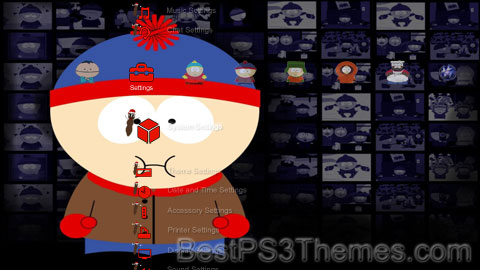
(8 backgrounds)
| South Park | |
|---|---|
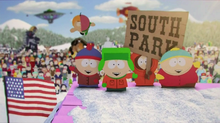 | |
| Genre | |
| Created by | |
| Developed by | Brian Graden |
| Showrunners |
|
| Voices of |
|
| Theme music composer | Primus |
| Composers |
|
| Country of origin | United States |
| Original language | English |
| No. of seasons | 26 |
| No. of episodes | 328 (list of episodes) |
| Production | |
| Executive producers |
|
| Producers |
|
| Cinematography | Kenny Gioseffi |
| Running time | 22 minutes[1] |
| Production companies |
|
| Original release | |
| Network | Comedy Central[nb 1] |
| Release | August 13, 1997 – present |
| Related | |
| The Spirit of Christmas | |
South Park is an American animated sitcom created by Trey Parker and Matt Stone and developed by Brian Graden for Comedy Central. The series revolves around four boys—Stan Marsh, Kyle Broflovski, Eric Cartman, and Kenny McCormick—and their exploits in and around the titular Colorado town. South Park also features many recurring characters. The series became infamous for its profanity and dark, surreal humor that satirizes a large range of subject matter.
Parker and Stone developed South Park from two animated short films, both titled The Spirit of Christmas, released in 1992 and 1995. The second short became one of the first Internet viral videos, leading to the series' production. The pilot episode was produced using cutout animation; the remainder of the series uses computer animation recalling the prior technique. Since the fourth season, episodes are generally written and produced during the week preceding its broadcast, with Parker serving as the lead writer and director.
Since its debut on August 13, 1997, 328 episodes of South Park have been broadcast. It debuted with great success, consistently earning the highest ratings of any basic cable program. Subsequent ratings have varied, but it remains one of Comedy Central's longest-running programs. In August 2021, South Park was renewed through 2027, and a series of television specials was announced for Paramount+, the first two of which were released later that year.[2][3] In October 2019, it was announced that WarnerMedia acquired exclusive streaming rights to South Park starting in June 2020 for HBO Max.[4] The series' twenty-sixth season premiered on February 8, 2023.[5]
South Park has received critical acclaim, and is included in various publications' lists of the greatest television shows. It has received numerous accolades, including five Primetime Emmy Awards and a Peabody Award. A theatrical film, South Park: Bigger, Longer & Uncut, was released in June 1999 to commercial and critical success, garnering an Academy Award nomination. In 2013, TV Guide ranked South Park the tenth Greatest TV Cartoon of All Time.[6]
South Park centers around four boys: Stan Marsh, Kyle Broflovski, Eric Cartman and Kenny McCormick. The boys live in the fictional small town of South Park, located within the real-life South Park basin in the Rocky Mountains of central Colorado,[7] approximately a one-hour drive from Denver.[8] The town is also home to an assortment of other characters, including students, families, elementary school staff, and other various residents.[9] Prominent settings include South Park Elementary, various neighborhoods and the surrounding mountain range, actual Colorado landmarks, and the businesses along the town's main street, all of which are based on the appearance of similar locations in Fairplay, Colorado.[7][9] As one of the few television programs set in the Mountain West region that takes place outside the urban core of Denver, South Park frequently features the unique culture of the region, including cattle ranchers, Old West theme parks, snowy climates, mountaineering, Mormons, real-life Colorado locations such as Casa Bonita and Cave of the Winds, and many other regionally specific characteristics.
Stan is portrayed as an average American boy; however, he has many mishaps throughout the series. In the first 22 seasons, Stan lived in South Park, but in the episodes during and after season 22, Stan resided in Tegridy Farms. Kyle is Jewish, and his portrayal as one of the few such people in South Park is often dealt with satirically.[10] Stan is modeled after Parker, while Kyle is modeled after Stone. They are best friends, and their friendship, symbolically intended to reflect Parker and Stone's friendship,[11] is a common topic throughout the series. Cartman (as he is commonly referred to) is amoral and increasingly psychopathic, and is commonly portrayed as an antagonist. His staunch antisemitism has resulted in a progressive rivalry with Kyle.[10][12] Kenny, who comes from a poor family, tightly wears his parka hood to the point where it obscures most of his face and muffles his speech. During the first five seasons, Kenny died in almost every episode before reappearing in the next with no definite explanation. He was killed off in the fifth season episode "Kenny Dies", before being reintroduced in the sixth season finale, "Red Sleigh Down". Since then, Kenny is depicted as dying sporadically. During the first 58 episodes, the children were in the third grade. During the fourth season, they entered the fourth grade, where they have remained ever since.[13][14]
Plots are often set in motion by events, ranging from the fairly typical to the supernatural and extraordinary, which frequently happen in the town.[15] The boys often act as the voice of reason when these events cause panic or incongruous behavior among the adult populace, who are customarily depicted as irrational, gullible, and prone to overreaction.[7][16] They are frequently confused by the contradictory and hypocritical behavior of their parents and other adults, and often perceive them as having distorted views on morality and society.[9][17]
Each episode opens with a tongue-in-cheek all persons fictitious disclaimer: "All characters and events in this show—even those based on real people—are entirely fictional. All celebrity voices are impersonated.....poorly. The following program contains coarse language and due to its content it should not be viewed by anyone."[18][19]
South Park was the first weekly program to be rated TV-MA,[20] and is generally intended for adult audiences.[21][22][23] The boys and most other child characters use strong profanity, with only the most taboo words being bleeped during a typical broadcast.[9] Parker and Stone perceive this as the manner in which real-life small boys speak when they are alone.[24][25]
South Park commonly makes use of carnivalesque and absurdist techniques,[26] numerous running gags,[27][28] violence,[28][29] sexual content,[30][31] offhand pop-cultural references, and satirical portrayal of celebrities.[32]
Early episodes tended to be shock value-oriented and featured more slapstick-style humor.[33] While social satire had been used on the show occasionally earlier on, it became more prevalent as the series progressed, with the show retaining some of its focus on the boys' fondness of scatological humor in an attempt to remind adult viewers "what it was like to be eight years old".[10] Parker and Stone also began further developing other characters by giving them larger roles in certain storylines,[10] and began writing plots as parables based on religion, politics, and numerous other topics.[9] This provided the opportunity for the show to spoof both extreme sides of contentious issues,[34] while lampooning both liberal and conservative points of view.[9][16][35] Rebecca Raphael described the show as "an equal opportunity offender",[15] while Parker and Stone describe their main purpose as to "be funny" and "make people laugh",[36][37] while stating that no particular topic or group of people be exempt from mockery and satire.[16][32][38][39][40]
Parker and Stone insist that the show is still more about "kids being kids" and "what it's like to be in [elementary school] in America",[41] stating that the introduction of a more satirical element to the series was the result of the two adding more of a "moral center" to the show so that it would rely less on simply being crude and shocking in an attempt to maintain an audience.[36][37] While profane, Parker notes that there is still an "underlying sweetness" aspect to the child characters,[34] and Time described the boys as "sometimes cruel but with a core of innocence".[11] Usually, the boys or other characters pondered over what transpired during an episode and conveyed the important lesson taken from it with a short monologue. During earlier seasons, this speech commonly began with a variation of the phrase "You know, I've learned something today...".[42]
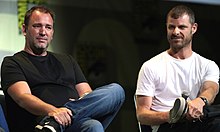
Parker and Stone met in film class at the University of Colorado in 1992 and discovered a shared love of Monty Python, which they often cite as one of their primary inspirations.[43] They created an animated short entitled The Spirit of Christmas.[27] The film was created by animating construction paper cutouts with stop motion, and features prototypes of the main characters of South Park, including a character resembling Cartman but named "Kenny", an unnamed character resembling what is today Kenny, and two near-identical unnamed characters who resemble Stan and Kyle. Fox Broadcasting Company executive and mutual friend Brian Graden commissioned Parker and Stone to create a second short film as a video Christmas card. Created in 1995, the second The Spirit of Christmas short resembled the style of the later series more closely.[44] To differentiate between the two homonymous shorts, the first short is often referred to as Jesus vs. Frosty, and the second short as Jesus vs. Santa. Graden sent copies of the video to several of his friends, and from there it was copied and distributed, including on the internet, where it became one of the first viral videos.[27][11]
As Jesus vs. Santa became more popular, Parker and Stone began talks of developing the short into a television series about four children residing in the fictional Colorado town of South Park. Fox eagerly agreed to meet with the duo about the show's premise, having prided itself on edgier products such as Cops, The Simpsons, and The X-Files. However, during the meeting at the Fox office in Century City, disagreements between the two creators and the network began to arise, mainly over the latter's refusal to air a show that included a supporting talking stool character named Mr. Hankey. Some executives at 20th Century Fox Television (which was to produce the series) agreed with its then-sister network's stance on Mr. Hankey and repeatedly requested Parker and Stone to remove the character in order for the show to proceed. Refusing to meet their demands, the duo cut ties with Fox and its sister companies all together and began shopping the series somewhere else.[45][46][47]
The two then entered negotiations with both MTV and Comedy Central. Parker preferred the show be produced by Comedy Central, fearing that MTV would turn it into a kids show.[48] When Comedy Central executive Doug Herzog watched the short, he commissioned for it to be developed into a series.[27][49] Parker and Stone assembled a small staff and spent three months creating the pilot episode "Cartman Gets an Anal Probe".[50] South Park was in danger of being canceled before it even aired when the show fared poorly with test audiences, particularly with women. However, the shorts were still gaining more popularity over the Internet, and Comedy Central ordered a run of six episodes.[36][48] South Park debuted with "Cartman Gets an Anal Probe" on August 13, 1997.[51]
Except for the pilot episode, which was produced using cutout animation, all episodes of South Park are created with the use of software, primarily Autodesk Maya.[52] As opposed to the pilot, which took three months to complete,[53] and other animated sitcoms, which are traditionally hand-drawn by companies in South Korea in a process that takes roughly eight to nine months,[27][35] individual episodes of South Park take significantly less time to produce. Using computers as an animation method, the show's production staff were able to generate an episode in about three weeks during the first seasons.[54] Now, with a staff of about 70 people, episodes are typically completed in one week,[27][34][35] with some in as little as three to four days.[55][56][57] Nearly the entire production of an episode is accomplished within one set of offices, which were originally at a complex in Westwood, Los Angeles, California and are now part of South Park Studios in Culver City, California.[49][53] Parker and Stone have been the show's executive producers throughout its entire history.[58] Debbie Liebling, who was Senior Vice President of original programming and development for Comedy Central, also served as an executive producer during the show's first five seasons, coordinating the show's production efforts between South Park Studios and Comedy Central's headquarters in New York City.[59][60] During its early stages, finished episodes of South Park were hastily recorded to D-2 to be sent to Comedy Central for airing in just a few days' time.[61] Each episode used to cost $250,000.[62]

Scripts are not written before a season begins.[63] Production of an episode begins on a Thursday, with the show's writing consultants brainstorming with Parker and Stone. Former staff writers include Pam Brady, who has since written scripts for the films Hot Rod, Hamlet 2 and Team America: World Police (with Parker and Stone), and Nancy Pimental, who served as co-host of Win Ben Stein's Money and wrote the film The Sweetest Thing after her tenure with the show during its first three seasons.[64][65] Television producer and writer Norman Lear, an alleged idol of both Parker and Stone, served as a guest writing consultant for the season seven (2003) episodes "Cancelled" and "I'm a Little Bit Country".[63][66][67] During the 12th and 13th seasons, Saturday Night Live actor and writer Bill Hader served as a creative consultant and co-producer.[68][69][70]
After exchanging ideas, Parker will write a script, and from there the entire team of animators, editors, technicians, and sound engineers will each typically work 100–120 hours in the ensuing week.[50] Since the show's fourth season (2000), Parker has assumed most of the show's directorial duties, while Stone relinquished his share of the directing to focus on handling the coordination and business aspects of the production.[27][71] On Wednesday, a completed episode is sent to Comedy Central's headquarters via satellite uplink, sometimes just a few hours before its air time of 10 PM Eastern Time.[27][72]
Parker and Stone state that subjecting themselves to a one-week deadline creates more spontaneity amongst themselves in the creative process, which they feel results in a funnier show.[27] The schedule also allows South Park to both stay more topical and respond more quickly to specific current events than other satiric animated shows.[10][73] One of the earliest examples of this was in the season four (2000) episode "Quintuplets 2000", which references the United States Border Patrol's raid of a house during the Elián González affair, an event which occurred only four days before the episode originally aired.[74] The season nine (2005) episode "Best Friends Forever" references the Terri Schiavo case,[25][34] and originally aired in the midst of the controversy and less than 12 hours before she died.[35][75] A scene in the season seven (2003) finale "It's Christmas in Canada" references the discovery of dictator Saddam Hussein in a "spider hole" and his subsequent capture, which happened a mere three days prior to the episode airing.[76] The season 12 (2008) episode "About Last Night..." revolves around Barack Obama's victory in the 2008 presidential election, and aired less than 24 hours after Obama was declared the winner, using segments of dialogue from Obama's real victory speech.[77]
On October 16, 2013, the show failed to meet their production deadline for the first time ever, after a power outage on October 15 at the production studio prevented the episode, season 17's "Goth Kids 3: Dawn of the Posers", from being finished in time. The episode was rescheduled to air a week later on October 23, 2013.[78]
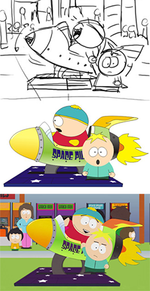
The show's style of animation is inspired by the paper cut-out cartoons made by Terry Gilliam for Monty Python's Flying Circus, of which Parker and Stone have been lifelong fans.[48][11][79] Construction paper and traditional stop motion cutout animation techniques were used in the original animated shorts and in the pilot episode. Subsequent episodes have been produced by computer animation, providing a similar look to the originals while requiring a fraction of the time to produce. Before computer artists begin animating an episode, a series of animatics drawn in Toon Boom are provided by the show's storyboard artists.[50][80]
The characters and objects are composed of simple geometrical shapes and primary and secondary colors. Most child characters are the same size and shape, and are distinguished by their clothing, hair and skin colors, and headwear.[17] Characters are mostly presented two-dimensionally and from only one angle. Their movements are animated in an intentionally jerky fashion, as they are purposely not offered the same free range of motion associated with hand-drawn characters.[10][53][81] Occasionally, some non-fictional characters are depicted with photographic cutouts of their actual head and face in lieu of a face reminiscent of the show's traditional style. Canadians on the show are often portrayed in an even more minimalist fashion; they have simple beady eyes, and the top halves of their heads simply flap up and down when the characters speak.[38]
When the show began using computers, the cardboard cutouts were scanned and re-drawn with CorelDRAW, then imported into PowerAnimator, which was used with SGI workstations to animate the characters.[50][53] The workstations were linked to a 54-processor render farm that could render 10 to 15 shots an hour.[50] Beginning with
X-Men ’08 theme by ZHero
Download: X-Men08.p3t
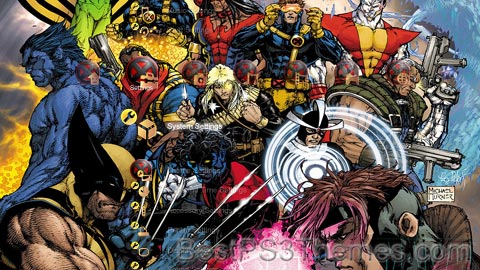
(6 backgrounds)
P3T Unpacker v0.12
Copyright (c) 2007. Anoop Menon
This program unpacks Playstation 3 Theme files (.p3t) so that you can touch-up an existing theme to your likings or use a certain wallpaper from it (as many themes have multiple). But remember, if you use content from another theme and release it, be sure to give credit!
Download for Windows: p3textractor.zip
Instructions:
Download p3textractor.zip from above. Extract the files to a folder with a program such as WinZip or WinRAR. Now there are multiple ways to extract the theme.
The first way is to simply open the p3t file with p3textractor.exe. If you don’t know how to do this, right click the p3t file and select Open With. Alternatively, open the p3t file and it will ask you to select a program to open with. Click Browse and find p3textractor.exe from where you previously extracted it to. It will open CMD and extract the theme to extracted.[filename]. After that, all you need to do for any future p3t files is open them and it will extract.
The second way is very simple. Just drag the p3t file to p3textractor.exe. It will open CMD and extract the theme to extracted.[filename].
For the third way, first put the p3t file you want to extract into the same folder as p3textractor.exe. Open CMD and browse to the folder with p3extractor.exe. Enter the following:
p3textractor filename.p3t [destination path]Replace filename with the name of the p3t file, and replace [destination path] with the name of the folder you want the files to be extracted to. A destination path is not required. By default it will extract to extracted.filename.
Bleach versionD 02 theme by Deemy
Download: Bleach_versionD02_241.p3t
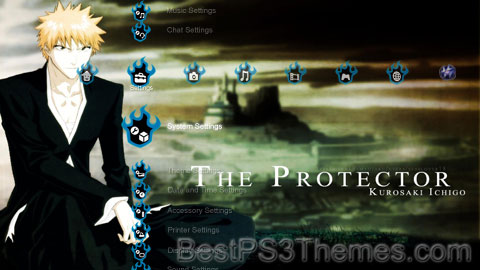
(16 backgrounds)
P3T Unpacker v0.12
Copyright (c) 2007. Anoop Menon
This program unpacks Playstation 3 Theme files (.p3t) so that you can touch-up an existing theme to your likings or use a certain wallpaper from it (as many themes have multiple). But remember, if you use content from another theme and release it, be sure to give credit!
Download for Windows: p3textractor.zip
Instructions:
Download p3textractor.zip from above. Extract the files to a folder with a program such as WinZip or WinRAR. Now there are multiple ways to extract the theme.
The first way is to simply open the p3t file with p3textractor.exe. If you don’t know how to do this, right click the p3t file and select Open With. Alternatively, open the p3t file and it will ask you to select a program to open with. Click Browse and find p3textractor.exe from where you previously extracted it to. It will open CMD and extract the theme to extracted.[filename]. After that, all you need to do for any future p3t files is open them and it will extract.
The second way is very simple. Just drag the p3t file to p3textractor.exe. It will open CMD and extract the theme to extracted.[filename].
For the third way, first put the p3t file you want to extract into the same folder as p3textractor.exe. Open CMD and browse to the folder with p3extractor.exe. Enter the following:
p3textractor filename.p3t [destination path]Replace filename with the name of the p3t file, and replace [destination path] with the name of the folder you want the files to be extracted to. A destination path is not required. By default it will extract to extracted.filename.
Izuna The Unemployed Ninja SD theme by Enzan_Blues
Download: IzunaTheUnemployedNinjaSD.p3t
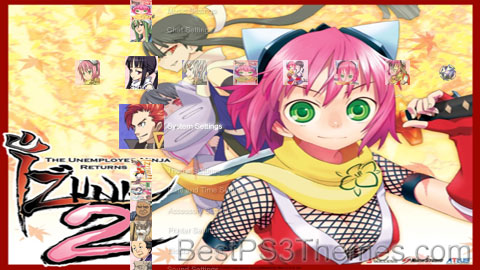
(7 backgrounds)
P3T Unpacker v0.12
Copyright (c) 2007. Anoop Menon
This program unpacks Playstation 3 Theme files (.p3t) so that you can touch-up an existing theme to your likings or use a certain wallpaper from it (as many themes have multiple). But remember, if you use content from another theme and release it, be sure to give credit!
Download for Windows: p3textractor.zip
Instructions:
Download p3textractor.zip from above. Extract the files to a folder with a program such as WinZip or WinRAR. Now there are multiple ways to extract the theme.
The first way is to simply open the p3t file with p3textractor.exe. If you don’t know how to do this, right click the p3t file and select Open With. Alternatively, open the p3t file and it will ask you to select a program to open with. Click Browse and find p3textractor.exe from where you previously extracted it to. It will open CMD and extract the theme to extracted.[filename]. After that, all you need to do for any future p3t files is open them and it will extract.
The second way is very simple. Just drag the p3t file to p3textractor.exe. It will open CMD and extract the theme to extracted.[filename].
For the third way, first put the p3t file you want to extract into the same folder as p3textractor.exe. Open CMD and browse to the folder with p3extractor.exe. Enter the following:
p3textractor filename.p3t [destination path]Replace filename with the name of the p3t file, and replace [destination path] with the name of the folder you want the files to be extracted to. A destination path is not required. By default it will extract to extracted.filename.
Izuna The Unemployed Ninja theme by Enzan_Blues
Download: IzunaTheUnemployedNinja.p3t

(7 backgrounds)
P3T Unpacker v0.12
Copyright (c) 2007. Anoop Menon
This program unpacks Playstation 3 Theme files (.p3t) so that you can touch-up an existing theme to your likings or use a certain wallpaper from it (as many themes have multiple). But remember, if you use content from another theme and release it, be sure to give credit!
Download for Windows: p3textractor.zip
Instructions:
Download p3textractor.zip from above. Extract the files to a folder with a program such as WinZip or WinRAR. Now there are multiple ways to extract the theme.
The first way is to simply open the p3t file with p3textractor.exe. If you don’t know how to do this, right click the p3t file and select Open With. Alternatively, open the p3t file and it will ask you to select a program to open with. Click Browse and find p3textractor.exe from where you previously extracted it to. It will open CMD and extract the theme to extracted.[filename]. After that, all you need to do for any future p3t files is open them and it will extract.
The second way is very simple. Just drag the p3t file to p3textractor.exe. It will open CMD and extract the theme to extracted.[filename].
For the third way, first put the p3t file you want to extract into the same folder as p3textractor.exe. Open CMD and browse to the folder with p3extractor.exe. Enter the following:
p3textractor filename.p3t [destination path]Replace filename with the name of the p3t file, and replace [destination path] with the name of the folder you want the files to be extracted to. A destination path is not required. By default it will extract to extracted.filename.